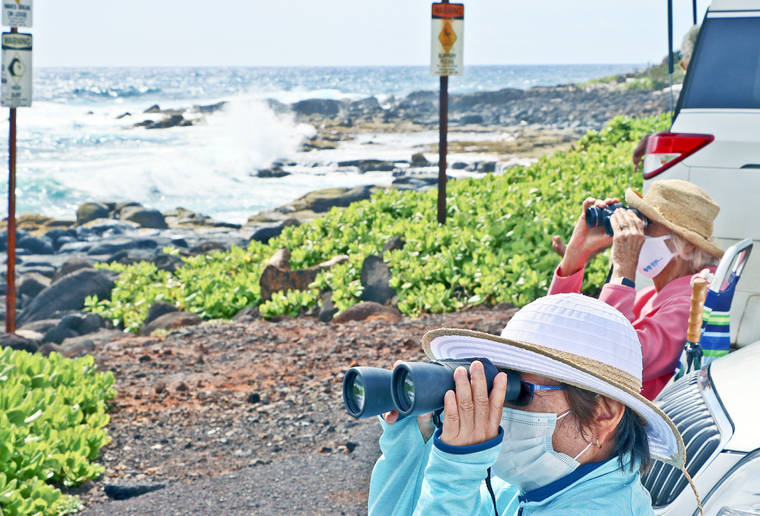LIHU‘E — Ahuhini site leader Colleen Ogino said Mike Kano at the Ninini Point Lighthouse was going to have a field day Saturday during the Hawaiian Islands Humpback Whale National Sanctuary Ocean Count that included 68 trained site leaders collecting data from 42 sites along the shores of O‘ahu, Kaua‘i and Hawai‘i Island.
“We saw a couple of whales,” Ogino said. “But they were to the south and heading towards Ninini Point. Mike will probably pick them up. They’re heading his way.”
According to Cindy Among-Serrao of the National Marine Sanctuary Foundation, a total of 118 whale sightings were reported during the 9:30 to 9:45 a.m. time period, the most of any time period throughout the day’s count that included the Great Whale Count by Pacific Whale Foundation on Maui.
“A whopping nine whales per 15-minute count period were sighted at the Ninini Point Lighthouse by site leader Mike Kano,” said Jean Souza, Kaua‘i program specialist. “He also observed 12 to 20 whales in one group for an hour and a half despite the strong winds and choppy waters.”
Souza said viewing conditions for the March count were better than on the previous count days in January and February.
“For six of the seven ocean-count sites that were used on Kaua‘i, the March 27 sightings of humpback whales was the highest of the three counts this year,” she said. “Many of the Kaua‘i sites reported lots of surface-active behavior, with the most number of whales sighted at Kaua‘i sites being between 8:30 to 9:45 a.m.”
Among-Serrao said across the Hawaiian Islands, weather conditions at a majority of the sites were either sunny or overcast with calm seas, making for good whale-viewing conditions.
A variety of other species were also spotted during the count period that started at 8 a.m. and ran until 12:15 p.m. These included honu, or green sea turtles, spinner dolphins, and multiple sea bird species like white terns, shearwaters, frigate birds and more.
On O‘ahu, the average number of whale sightings per 15-minute count period ended at 2.8 whales, Hawai‘i Island finished with 0.17 whales, and Kaua‘i topped the other islands with an average of 3.8 whales sighted.
“Site leaders Perry Maglidt and Steve Ball reported a mom and calf who stayed in the vicinity of Crater Hill at Kilauea Point National Wildlife Refuge for the entire four-plus-hour count,” Souza said.
“Site leaders Beck Fries and Donna Wilcox reported from Makahuena Point in Po‘ipu that they observed 131 slaps, including tail slaps, pec slaps and head slaps, within the first hour of 8 to 9 a.m.”
Souza said the pandemic situation resulted in the Sanctuary Ocean Count modified statewide to be managed differently than in prior years.
“I’m sure there were many disappointed folks who would have wanted to participate, and who would’ve stopped by to talk to the volunteers and learn about what the whales were up to,” she said.
“This season, including the last Saturday of January, February and March, only experienced site leaders were allowed to conduct the count under the National Marine Sanctuary Foundation, which adopted the project when the Hawaiian Islands Humpback Whale National Sanctuary was not able to do it. The normally-very-friendly-and-helpful site leaders were instructed to follow COVID-safe protocols of mask-wearing and physical-distancing. Public interactions were discouraged,” she said.
The Ocean Count promotes public awareness about humpback whales, the Hawaiian Islands Humpback Whale National Marine Sanctuary and shore-based whale-watching opportunities. Site leaders tally humpback-whale sightings during the survey period to provide a snapshot of humpback-whale activity from the shorelines of O‘ahu, Kaua‘i and Hawai‘i Island.
•••
Dennis Fujimoto, staff writer and photographer, can be reached at 245-0453 or dfujimoto@thegardenisland.com.


